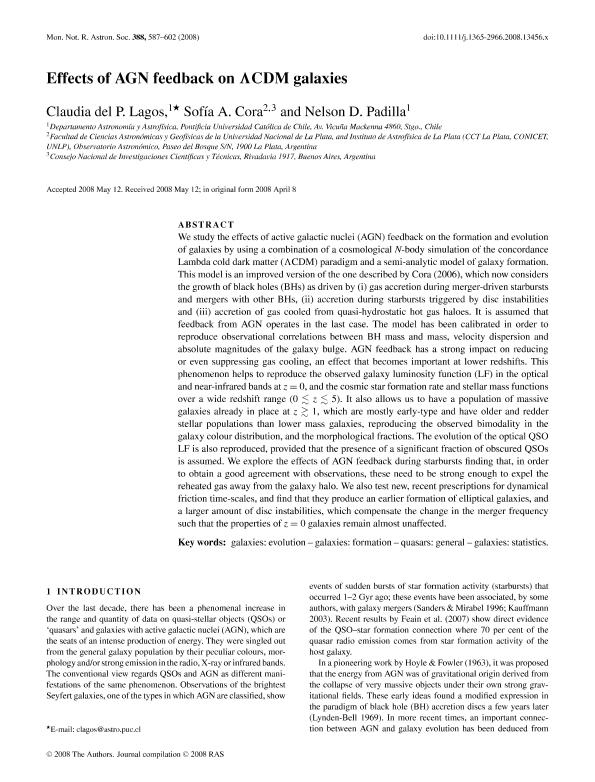Mostrar el registro sencillo del ítem
dc.contributor.author
Lagos, Claudia del Pilar
dc.contributor.author
Cora, Sofia Alejandra

dc.contributor.author
Padilla, Nelson D.
dc.date.available
2018-04-24T13:36:34Z
dc.date.issued
2008-12
dc.identifier.citation
Lagos, Claudia del Pilar; Cora, Sofia Alejandra; Padilla, Nelson D.; Effects of AGN feedback on LCDM galaxies; Wiley Blackwell Publishing, Inc; Monthly Notices of the Royal Astronomical Society; 388; 12-2008; 587-602
dc.identifier.issn
0035-8711
dc.identifier.uri
http://hdl.handle.net/11336/43220
dc.description.abstract
We study the effects of Active Galactic Nuclei (AGN) feedback on the formation and evolution of galaxies in a semi-analytic model of galaxy formation. This model is an improved version of the one described by Cora (2006), which now considers the growth of black holes (BHs) as driven by (i) gas accretion during merger-driven starbursts and mergers with other BHs, (ii) accretion during starbursts triggered by disc instabilities, and (iii) accretion of gas cooled from quasi-hydrostatic hot gas haloes. It is assumed that feedback from AGN operates in the later case. The model has been calibrated in order to reproduce observational correlations between BH mass and mass, velocity dispersion, and absolute magnitudes of the galaxy bulge. AGN feedback has a strong impact on reducing or even suppressing gas cooling, an effect that becomes important at lower redshifts. This phenomenon helps to reproduce the observed galaxy luminosity function (LF) in the optical and near IR bands at z=0, and the cosmic star formation rate and stellar mass functions over a wide redshift range (0<z<5). It also allows to have a population of massive galaxies already in place at z>1, which are mostly early-type and have older and redder stellar populations than lower mass galaxies, reproducing the observed bimodality in the galaxy colour distribution, and the morphological fractions. The evolution of the optical QSO LF is also reproduced, provided that the presence of a significant fraction of obscured QSOs is assumed. We explore the effects of AGN feedback during starbursts and new recent prescriptions for dynamical friction time-scales. (ABRIDGED)
dc.format
application/pdf
dc.language.iso
eng
dc.publisher
Wiley Blackwell Publishing, Inc

dc.rights
info:eu-repo/semantics/openAccess
dc.rights.uri
https://creativecommons.org/licenses/by-nc-sa/2.5/ar/
dc.subject
Evolution of Galaxies
dc.subject
Formation of Galaxies
dc.subject
Quasars
dc.subject
Statistics
dc.subject
Active Galactic Nuclei
dc.subject.classification
Astronomía

dc.subject.classification
Ciencias Físicas

dc.subject.classification
CIENCIAS NATURALES Y EXACTAS

dc.title
Effects of AGN feedback on LCDM galaxies
dc.type
info:eu-repo/semantics/article
dc.type
info:ar-repo/semantics/artículo
dc.type
info:eu-repo/semantics/publishedVersion
dc.date.updated
2018-04-23T15:35:02Z
dc.journal.volume
388
dc.journal.pagination
587-602
dc.journal.pais
Reino Unido

dc.journal.ciudad
Londres
dc.description.fil
Fil: Lagos, Claudia del Pilar. Pontificia Universidad Católica de Chile; Chile
dc.description.fil
Fil: Cora, Sofia Alejandra. Universidad Nacional de La Plata. Facultad de Ciencias Astronómicas y Geofísicas; Argentina. Consejo Nacional de Investigaciones Científicas y Técnicas. Centro Científico Tecnológico Conicet - La Plata. Instituto de Astrofísica La Plata. Universidad Nacional de La Plata. Facultad de Ciencias Astronómicas y Geofísicas. Instituto de Astrofísica La Plata; Argentina
dc.description.fil
Fil: Padilla, Nelson D.. Pontificia Universidad Católica de Chile; Chile
dc.journal.title
Monthly Notices of the Royal Astronomical Society

dc.relation.alternativeid
info:eu-repo/semantics/altIdentifier/doi/http://dx.doi.org/10.1111/j.1365-2966.2008.13456.x
dc.relation.alternativeid
info:eu-repo/semantics/altIdentifier/url/https://academic.oup.com/mnras/article/388/2/587/977114
Archivos asociados
